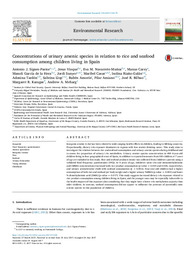Título :
Concentrations of urinary arsenic species in relation to rice and seafood consumption among children living in Spain |
Autor :
Signes-Pastor, Antonio Jose 
Vioque, Jesús
Navarrete-Muñoz, Eva María
Carey, Manus 
Garcia de la Hera, Manuela 
Sunyer, Jordi
Casas, Maribel 
Riaño-Galan, Isolina 
Tardon, Adonina 
Llop, Sabrina
Amorós, Rubén
Amiano, Pilar 
Bilbao, José R.
Karagas, Margaret R 
Meharg, Andrew A. |
Editor :
Elsevier |
Departamento:
Departamentos de la UMH::Salud Pública, Historia de la Ciencia y Ginecología
Departamentos de la UMH::Patología y Cirugía |
Fecha de publicación:
2017-07-26 |
URI :
https://hdl.handle.net/11000/30785 |
Resumen :
Inorganic arsenic (i-As) has been related to wide-ranging health effects in children, leading to lifelong concerns.
Proportionally, dietary i-As exposure dominates in regions with low arsenic drinking water. This study aims to
investigate the relation between rice and seafood consumption and urinary arsenic species during childhood and to assess the proportion of urinary i-As metabolites. Urinary arsenic species concentration in 400 4-year-old children living in four geographical areas of Spain, in addition to repeated measures from 100 children at 7 years of age are included in this study. Rice and seafood products intake was collected from children's parents using a validated food frequency questionnaire (FFQ). At 4 years of age, children's urine i-As and monomethylarsonic acid (MMA) concentrations increased with rice product consumption (p-value = 0.010 and 0.018, respectively), and urinary arsenobetaine (AsB) with seafood consumption (p = 0.002). Four-year-old children had a higher consumption of both rice and seafood per body weight and a higher urinary %MMA (p-value=0.001) and lower % dimethylarsinic acid (DMA) (p-value = 0.017). This study suggests increased dietary i-As exposure related to rice product consumption among children living in Spain, and the younger ones may be especially vulnerable to the health impacts of this exposure also considering that they might have a lower i-As methylation capacity than older children. In contrast, seafood consumption did not appear to influence the presence of potentially toxic arsenic species in this population of children.
|
Palabras clave/Materias:
Food frequency questionnaire
Arsenic speciation
Inorganic arsenic
Rice
Seafood
Urinary biomarker
Young children
Childhood |
Tipo de documento :
info:eu-repo/semantics/article |
Derechos de acceso:
info:eu-repo/semantics/openAccess
Attribution-NonCommercial-NoDerivatives 4.0 Internacional |
DOI :
http://dx.doi.org/10.1016/j.envres.2017.07.046 |
Aparece en las colecciones:
Artículos Salud Pública, Historia de la Ciencia y Ginecología
|

 La licencia se describe como: Atribución-NonComercial-NoDerivada 4.0 Internacional.
La licencia se describe como: Atribución-NonComercial-NoDerivada 4.0 Internacional.
.png)